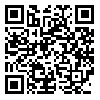BibTeX | RIS | EndNote | Medlars | ProCite | Reference Manager | RefWorks
Send citation to:
URL: http://jdm.tums.ac.ir/article-1-351-en.html
Statement of Problem: Craniocervical Posture is a factor in the development and function of Craniofacial Structure. Previous studies of different samples have demonstrated associations between craniocervical posture and craniofacial morphology.
Purpose: This study aimed lo examine whether any significant association is evident or not between craniocervical posture and the occurrence of Class il & Class III skeletal malocclusions.
Materials and Methods: A sample of 76 subjects with Class II & Class III skeletal malocclusion aged 9-i 1 and>18 years were selected. None of them had received orthodontic treatment. Lateral cephalometric radiographs were taken in natural head position (NHP), and craniocervical and craniohorizental angels were traced and determined for analysis of craniocervical posture.
Results: According to the craniocervical posture, most class II skeletal patients have flexed heads and class MI skeletal patients have extended heads, as a result malocclusion in these patients seems to become more severe.With increase in age. class II skeletal patients have more flexed their heads and malocclusion become more severe, while with increase in age in class ill skeletal patients, their heads become extended and once again malocclusion thought lo be more severe. In class II skeletal patients, craniocervical posture has a significant correlation with the vertical growth pattern, but shows little correlation with the horizontal growth pattern. In class 111 skeletal patients, craniocervical posture shows no correlation to any of the vertical & horizontal growth patterns, of course the mean of vertical angles is less in these patients and probably in order to make these relation significant in Class III skeletal patients there is need for more samples, in class II & class III skeletal patients, the amount of Na.prep-point A and pog-Na.prep with craniocervical posture shows a significant correlation.
Conclusion: Consideration of craniocervical posture (in addition to cephalometric angles) lead to making better treatment planning.
| Rights and Permissions | |
 |
This work is licensed under a Creative Commons Attribution-NonCommercial 4.0 International License. |




